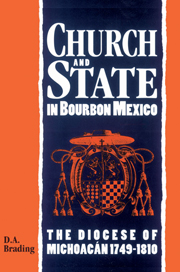6 - Priests
Published online by Cambridge University Press: 01 February 2010
Summary
In 1776 the Mexican savant, Antonio de León y Gama, described Michoacán ‘as the most populous and thriving bishopric in all America’, in which ‘one can say that the dominant language of the country is Castilian, since only in very remote villages where there is no trade, does one not hear it’. At its inception it had been divided into three geographical zones: the tierra caliente of the Pacific coasts and valleys; the tierra fria of the Michoacán highlands, the heartland of the former Tarascan kingdom; and the tierra templada which stretched northwards from Valladolid, a frontier zone colonised by Spaniards and Otomí Indians. But these traditional distinctions had been overtaken in the eighteenth century by the emergence of the Bajío, an area broadly coterminous with the central and southern sections of the modern state of Guanajuato, where the densely populated plains produced an abundance of foodstuffs for the mining city of Guanajuato, which by the 1790s counted no less than 55,000 inhabitants in its urban centre and surrounding industrial villages. Gama cited the diocesan census of 1761 which enumerated a grand total of 426,260 individuals aged seven years and above, of which 252,355 – almost 60 per cent – were described as Spaniards and castas, the remainder Indians who spoke Mexican (Nahuatl), Tarascan, Masahua and Otomí. But the population was growing at the rate of about 2.3 per cent a year and, despite the setback of the great famine of 1785–6, by 1810 was reliably estimated at over a million, divided as shown in Table 1.
- Type
- Chapter
- Information
- Church and State in Bourbon Mexico , pp. 105 - 130Publisher: Cambridge University PressPrint publication year: 1994



